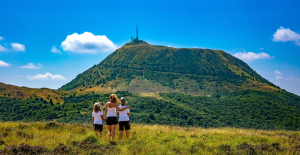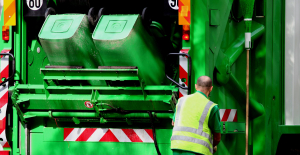In the heart of Iran, the thermometer often exceeds 40 degrees. But these extreme temperatures remain bearable thanks to wind towers, the ecological ancestors of air conditioning, which are once again of interest to architects. Located not far from the Silk Road, Yazd is one of the hottest cities in the world. Surrounded by two deserts, its summers are hot and the rains extremely rare. Its inhabitants have learned to adapt to it. With methods invented more than 2,500 years ago, when the Persian Empire dominated the Middle East.
Yazd is “living testimony to the intelligent use of the limited available resources necessary for survival in the desert”, sums up Unesco, which inscribed it in 2017 on the World Heritage List. This city of 530,000 inhabitants is "a source of inspiration for new architecture facing the challenges of sustainability", adds this UN organization.
Yazd is particularly famous for its some 700 badguirs (“wind catcher” in Persian), traditional and elegant towers which surmount the flat roofs of the historic center. “The badguirs played a major role in the prosperity of the city. For centuries, before the invention of electricity, they cooled homes. Thanks to them, people lived comfortably,” explains Abdolmajid Shakeri, head of the Ministry of Heritage for the province of Yazd.
Similar to straight four-sided chimneys, badguirs feature large vertical slits and multiple flues inside. They let the slightest breath of fresh air into the dwelling while, under pressure, the warm air is forced out. This method of refrigeration is "totally clean because it uses neither electricity nor polluting materials", underlines Majid Oloumi, director of the garden of Dowlat-Abad, where is located a badguir of 33 meters, the highest in the world.
This example of bioclimatic architecture inspires a growing number of architects around the world, such as the Franco-Iranian Roland Dehghan Kamaraji, based in Paris, who has extensively studied the functioning of badguirs. They "demonstrate that simplicity can be an essential attribute of sustainability, belying the widespread idea that sustainable solutions must necessarily be complex or high-tech", he defends.
Among the most representative projects, he cites that of Masdar City, in the United Arab Emirates, whose “buildings are designed to take advantage of natural ventilation for cooling, like badguirs.” In Melbourne, Australia, Council House 2 is also a building with a passive cooling system, like the Eastgate Center in Harare (Zimbabwe), which “is inspired by termite mounds, an approach similar to that of badguirs”.
In Yazd, towers and traditional houses are built of rammed earth, made of clay and raw earth, effective thermal insulators. Well preserved, the Old Town is also organized around narrow streets and "sabats", these partly covered passages that protect from the sun. The contrast is striking with the avenues of the modern city, wide and straight. "Unfortunately, the heritage transmitted by our ancestors has been forgotten", especially since the appearance of air conditioners, regrets Majid Oloumi. “Today, the architecture of the houses, coming from other countries, and the construction methods, based on cement, do not correspond to the climate of Yazd.”
Internationally, Roland Dehghan Kamaraji observes that a number of bioclimatic architecture projects remain hampered “by economic requirements and standards established by the industry”, which still mainly favors the use of materials that consume fossil fuels.
Specialists are also interested in another specialty of Yazd: the "qanats", these narrow underground galleries which carry water from the mountains or underground water tables to places of life. Built more than 2,000 years ago for some, “these underground aqueducts constitute a source of water supply and make it possible to cool the dwellings and to preserve food at an ideal temperature”, explains Zohreh Montazer, specialist in qanats of Yazd. The number of qanats in Iran is estimated at 33,000, compared to 50,000 in the middle of the 20th century, a drop linked in part to the drying up of groundwater due to overconsumption of water, according to Unesco.
Anxious to preserve this heritage, the Iranian state has rehabilitated the longest and oldest qanat in the country, that of Zarch, which extends over more than 70 km in the province of Yazd. This narrow gut is partially open to visitors, a way of making residents aware of the challenges ahead. "The day when fossil fuels run out, we will have to return to the methods" which have already been proven in Yazd, warns Zohreh Montazer.

 Ukraine has lost 10 million inhabitants since 2001... and could lose as many by 2050
Ukraine has lost 10 million inhabitants since 2001... and could lose as many by 2050 Russia: schools will train children to use drones at the start of the school year
Russia: schools will train children to use drones at the start of the school year Austria: incestuous torturer Josef Fritzl, nicknamed the “national monster”, could soon be released
Austria: incestuous torturer Josef Fritzl, nicknamed the “national monster”, could soon be released An airline continues to treat a centenarian as a one-year-old baby
An airline continues to treat a centenarian as a one-year-old baby Sánchez cancels his agenda and considers resigning: "I need to stop and reflect"
Sánchez cancels his agenda and considers resigning: "I need to stop and reflect" The Federal Committee of the PSOE interrupts the event to take to the streets with the militants
The Federal Committee of the PSOE interrupts the event to take to the streets with the militants Repsol: "We want to lead generative AI to guarantee its benefits and avoid risks"
Repsol: "We want to lead generative AI to guarantee its benefits and avoid risks" Osteoarthritis: an innovation to improve its management
Osteoarthritis: an innovation to improve its management The French will take advantage of the May bridges to explore France
The French will take advantage of the May bridges to explore France Organic flour contaminated by a recalled toxic plant
Organic flour contaminated by a recalled toxic plant 2024 Olympics: Parisian garbage collectors have filed a strike notice
2024 Olympics: Parisian garbage collectors have filed a strike notice Controversial free trade deal between EU and New Zealand comes into force this Wednesday
Controversial free trade deal between EU and New Zealand comes into force this Wednesday Lang Lang, the most French of Chinese pianists
Lang Lang, the most French of Chinese pianists Author of the “New York Trilogy”, American novelist Paul Auster has died at the age of 77
Author of the “New York Trilogy”, American novelist Paul Auster has died at the age of 77 To the End of the World, The Stolen Painting, Border Line... Films to watch this week
To the End of the World, The Stolen Painting, Border Line... Films to watch this week Omar Sy on all cultural fronts
Omar Sy on all cultural fronts Omoda 7, another Chinese car that could be manufactured in Spain
Omoda 7, another Chinese car that could be manufactured in Spain BYD chooses CA Auto Bank as financial partner in Spain
BYD chooses CA Auto Bank as financial partner in Spain Tesla and Baidu sign key agreement to boost development of autonomous driving
Tesla and Baidu sign key agreement to boost development of autonomous driving Skoda Kodiaq 2024: a 'beast' plug-in hybrid SUV
Skoda Kodiaq 2024: a 'beast' plug-in hybrid SUV The home mortgage firm rises 3.8% in February and the average interest moderates to 3.33%
The home mortgage firm rises 3.8% in February and the average interest moderates to 3.33% This is how housing prices have changed in Spain in the last decade
This is how housing prices have changed in Spain in the last decade The home mortgage firm drops 10% in January and interest soars to 3.46%
The home mortgage firm drops 10% in January and interest soars to 3.46% The jewel of the Rocío de Nagüeles urbanization: a dream villa in Marbella
The jewel of the Rocío de Nagüeles urbanization: a dream villa in Marbella Europeans: a senior official on the National Rally list
Europeans: a senior official on the National Rally list Blockade of Sciences Po: the right denounces a “drift”, the government charges the rebels
Blockade of Sciences Po: the right denounces a “drift”, the government charges the rebels Even on a mission for NATO, the Charles-de-Gaulle remains under French control, Lecornu responds to Mélenchon
Even on a mission for NATO, the Charles-de-Gaulle remains under French control, Lecornu responds to Mélenchon “Deadly Europe”, “economic decline”, immigration… What to remember from Emmanuel Macron’s speech at the Sorbonne
“Deadly Europe”, “economic decline”, immigration… What to remember from Emmanuel Macron’s speech at the Sorbonne These French cities that will boycott the World Cup in Qatar
These French cities that will boycott the World Cup in Qatar NBA: with 46 points, Maxey saves Philadelphia single-handedly
NBA: with 46 points, Maxey saves Philadelphia single-handedly Tennis: a Nadal-Alcaraz double at the 2024 Olympics? “If all goes well, yes,” replies the cadet
Tennis: a Nadal-Alcaraz double at the 2024 Olympics? “If all goes well, yes,” replies the cadet Tennis: “Actually it was a joke, I’ll come back next year!”, Nadal bids farewell to Madrid with humor and emotion
Tennis: “Actually it was a joke, I’ll come back next year!”, Nadal bids farewell to Madrid with humor and emotion Bayern Munich-Real Madrid: “Everything is still in our hands”, welcomes Manuel Neuer
Bayern Munich-Real Madrid: “Everything is still in our hands”, welcomes Manuel Neuer
















